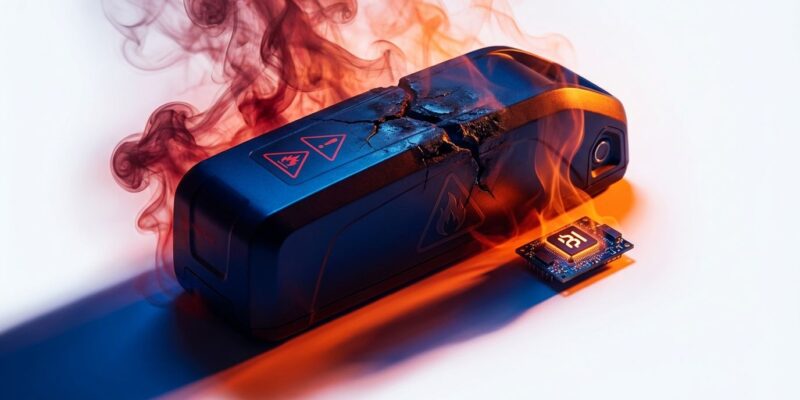
On November 24, the U.S. Consumer Product Safety Commission issued an emergency warning urging consumers to immediately stop using Rad Power Bikes batteries after 31 fire incidents caused injuries and $734,500 in property damage. Heres the twist: the Seattle-based e-bike maker is refusing to issue a formal recall—not out of defiance, but desperation. The company filed a shutdown notice weeks earlier and claims it cannot afford to replace batteries or refund customers, setting up a collision between consumer safety and corporate survival.
This isnt just another recall story. Its a cautionary tale for anyone building physical products: hardware failures arent fixable with software patches, and recalls can cost more than your company valuation.
The Perfect Storm: When Safety Crises Meet Financial Collapse
Rad Power Bikes faces twin disasters that couldnt have come at a worse time. The batteries in question—models RP-1304 and HL-RP-S1304—can “unexpectedly ignite and explode,” particularly when exposed to water and debris. Thats an inevitable condition for outdoor e-bikes marketed as transportation solutions. Nine models sold from 2017-2023 are affected: RadWagon 4, RadCity HS 4, RadRover High Step 5, RadCity Step Thru 3, RadRover Step Thru 1, RadRunner 2, RadRunner 1, RadRunner Plus, and RadExpand 5.
However, the crisis timing reveals the fundamental issue. Between November 7-10, Rad Power filed a Worker Adjustment and Retraining Notification (WARN) with Washington state, warning all 64 remaining employees of potential “cessation of operations” effective January 9, 2026. The company once valued at $1.65 billion after raising $329 million now admits it lacks resources to comply with a federal safety mandate.
Moreover, some fires occurred during storage when batteries werent charging or in use. That detail should terrify owners—you cant prevent these failures by being careful. The danger persists even when bikes sit unused.
Why Rad Power Bikes Wont Issue a Battery Recall
Conservative estimates put replacement costs at $25-35 million: 30,000+ affected units multiplied by $550 per battery, plus logistics, legal fees, and hazardous waste disposal. The companys current resources? The WARN filing suggests minimal cash reserves.
Furthermore, Rad Power offered a compromise: discounted upgrades to newer “Safe Shield batteries.” CPSC rejected it. The agency wants an all-or-nothing recall—free replacements or full refunds for every affected customer. Consequently, the company faces an impossible choice: comply and bankrupt immediately, or refuse and face liability.
Rad Powers defense rests on two arguments: their batteries allegedly meet UL-2271 and UL-2849 safety standards, and the failure rate is “a fraction of one percent.” Nevertheless, certification doesnt guarantee safety after five years of outdoor use. Those tests evaluate new batteries in lab conditions, not weathered batteries after real-world abuse.
From Unicorn to Bankruptcy in Five Years
Founded in 2007, Rad Power rode pandemic e-bike demand to $1.65 billion unicorn valuation in October 2021. They raised $329 million across five rounds, including investments from Fidelity and T. Rowe Price. At peak, they claimed 100,000+ owners across 30 countries.
Then demand corrected. Post-pandemic reality hit hard: excess inventory, dried-up funding, brutal hardware margins. The company experienced “more than seven rounds of layoffs” between 2022-2025, shrinking to 64 employees. Additionally, battery defects from products sold in 2017-2020 are only manifesting now, after the company lost its financial cushion.
What Affected Riders Should Do Now
If you own a Rad Power bike, check your battery model number immediately. Its printed on the battery casing. If it reads RP-1304 or HL-RP-S1304, stop using it. Period.
Therefore, CPSC directs consumers to dispose of affected batteries at municipal hazardous waste facilities—not regular recycling bins. Before disposal, document everything: photograph model numbers, save purchase receipts, record communications. Class-action lawsuits are likely, though they wont help if the company declares bankruptcy.
Consumers face a grim choice: abandon their $1,500-$2,000 investment with no refunds, continue using dangerous batteries, or wait for uncertain resolution. Whatever you do, dont sell or give away defective batteries—that creates liability for you.
Lessons for Hardware Founders: Budget for Recalls from Day One
Hardware startup statistics are brutal: 97 percent fail to deliver on time. Rad Power made textbook mistakes that turned quality control into an existential threat.
First, they likely sourced the cheapest batteries without extensive lifecycle testing. Full testing costs $500K-1M and takes 12-18 months. Companies under growth pressure choose faster, cheaper options. Second, they didnt maintain recall reserves or buy recall insurance. Out of $329 million raised, $5-10 million earmarked for recalls would have covered this crisis.
Third, they violated a cardinal rule: you cannot patch hardware like software. A code bug can be fixed overnight. A battery defect requires physical retrieval and disposal of every affected unit. Costs scale with units sold.
The lesson is clear: in hardware, safety isnt a feature you add later. Its the foundation. Budget for worst-case scenarios. Test beyond certification standards. Understand that “move fast and break things” is negligent when things can literally catch fire.
The Uncomfortable Truth
Rad Powers refusal is understandable but wrong. Consumer safety must override corporate survival. Nevertheless, CPSCs “all-or-nothing” approach exposes gaps in the regulatory system. Should federal agencies force companies into bankruptcy? If recalls bankrupt manufacturers, who supports existing customers?
The real villain isnt CPSC or even Rad Powers current leadership. Its the growth-first culture that pervaded 2019-2021. Founders prioritized fundraising and shipping volume over safety validation. They cut corners on battery sourcing to maintain pricing. They shipped products before completing extended testing. Consequently, consumers, employees, and investors all pay the price.
If you own an affected Rad Power bike, stop using it immediately. Check your battery model number, dispose of it safely, and document everything. If youre building hardware products, learn from this disaster: safety testing isnt optional, recalls arent edge cases, and insurance isnt paranoia.
Rad Power built something valuable and reached unicorn status—a rare achievement. But they forgot that in hardware, one bad batch can erase everything. Software companies patch bugs. Hardware companies recall products or declare bankruptcy. Theres no middle ground.











